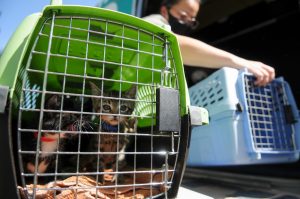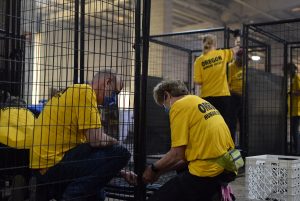OHS Incident Command team tackles challenges of disaster response during a pandemic
 Six months into the COVID-19 pandemic, Oregon faced another massive challenge. Wildfires were raging across the state — roaring through the Santiam Canyon, decimating towns in Southern Oregon and the coast range, and creeping dangerously close to some of the most densely populated areas in Oregon.
Six months into the COVID-19 pandemic, Oregon faced another massive challenge. Wildfires were raging across the state — roaring through the Santiam Canyon, decimating towns in Southern Oregon and the coast range, and creeping dangerously close to some of the most densely populated areas in Oregon.
Oregon Humane Society’s Incident Command team, already meeting regularly, shifted their focus to wildfire response.
Pivoting to Wildfire Response
“We deployed all of our resources to meet the specific needs in the affected communities,” says Jennifer Barta, OHS staff member who led planning through the wildfire incident. “We approached the response in three distinct ways.”
 OHS collaborated with agencies in the Portland metro-area to help pet owners from Clackamas County – sending teams into the field to deliver supplies, setting up kennels and caring for animals at evacuation sites.
OHS collaborated with agencies in the Portland metro-area to help pet owners from Clackamas County – sending teams into the field to deliver supplies, setting up kennels and caring for animals at evacuation sites.- OHS worked with partners around the state to transport shelter pets to Portland so space and resources were freed up to help pets and people directly impacted by the fires.
- OHS supplied pet food and supplies so evacuees could keep their pets with them. OHS also provided emergency boarding as a last resort for pet owners who were not able to stay with their pet.
In addition, stray cats from Clackamas County were brought to OHS for medical treatment and daily care until their owners could be located.
Managing Safety First
“But, we couldn’t forget that we were still operating during a global health crisis, so we always had to put our plans through that filter,” says Brian August, OHS Chief Operating Officer. “For example, if we were sending responders to an evacuation site, we made sure they had masks and could stay six feet apart if they were in the same vehicle, or we planned for separate vehicles.”
“Every aspect of managing operations during the wildfire was a challenge,” says Chase Patterson, OHS Operations Director and member of the Incident Command Team. “When we were bringing transports of pets to OHS, we had to make sure our processes kept employees safe from COVID-19 and the smoky air.”
To keep the hazardous air out of the shelter, dog walks were suspended and special indoor areas for potty breaks were set up. The OHS maintenance team brought in extra filters and air scrubbers to keep staff, adopters and the animals safe.
“Because this disaster was close to home, we also had employees and staff members who had to evacuate,” adds Jennifer. “We began planning for housing evacuated staff and their pets if needed. But, we needed to consider COVID if we had to activate those plans.”
As the smoke clears and the wildfires are contained, the response enters a new phase. With thousands of homes destroyed in these fires, rebuilding will be a long and difficult process.
Looking to the Future
“This year has presented challenges that none of us could have imagined a year ago,” adds Brian. “But as we look to the future, OHS’s New Road Ahead Initiative will ensure that we will be even better positioned to respond to multiple disasters at one time. The new dedicated Rescue Center will be an invaluable resource to house displaced pets, provide emergency boarding or other resources during a crisis.”







